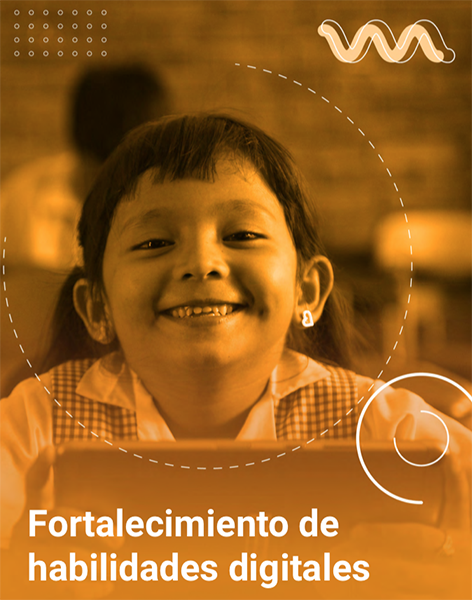
Foto: Ismael Martínez.
The digital revolutions we are experiencing have a profound impact on our way of life: from the proliferation of personal computers to the expansion of the Internet, the rise of social networks and the ubiquity of mobile connectivity, these changes have revolutionized the way we interact with the world. Today we are involved in more digital interactions than in the offline world, a reality that just a generation ago seemed like science fiction.
These transformations have immense potential to enrich our lives and improve our relationships. However, at the same time, they can be unfamiliar and bewildering. The speed with which digital technologies develop and the new worlds they create can be overwhelming, even for those of us who understand their potential to enhance education and broaden our horizons.
Education is a fundamental human right. However, and unfortunately, this right faces undeniable barriers that hinder its achievement. Social, economic and geographic inequalities are obstacles that make it difficult for many boys and girls to access information and educational resources in an equitable manner. Even so, in the midst of this complexity, the digital revolution emerges as a powerful ally with the potential to break down these barriers and establish the foundations of an inclusive and excellent education for each individual.
The path towards equal opportunities in education
It is undeniable that the dizzying development of technology can generate concerns and doubts about its impact on education. However, here we defend that, used with the appropriate purpose and direction, these advances can be put at the service of a more effective, inclusive and equitable education for all. In what direction should we walk to achieve this goal?

Foto: Ismael Martínez
First of all, it is important to know that when we talk about digital education, we are not referring to simple screens transmitting stimuli to girls and boys without rhyme or reason. Digital education is an approach that uses technology as a tool to facilitate the teaching and learning process, developing personal and intellectual skills in students. Technology in the classroom enables investigation, analysis, and interaction with information, ideas, and people in ways that previously seemed unattainable.
As we have mentioned, one of the main arguments in favour of digital education is its ability to address the social and economic inequalities that affect access to education. Many boys and girls in disadvantaged situations lack opportunities to access educational resources and content. Digital education can break down these barriers, providing access to more attractive and affordable content, and ensuring that everyone has equal opportunities to learn.
It is undeniable that the dizzying development of technology can generate concerns and doubts about its impact on education. However, here we defend that, used with the appropriate purpose and direction, these advances can be put at the service of a more effective, inclusive and equitable education for all.
In addition, in less developed and vulnerable countries, the quality of education systems is often deficient, which affects the skills development of students. The pedagogical use of technology can be a solution to focus on disadvantaged students and provide them with learning opportunities that they did not have before. Digital education can overcome quality issues by offering a more enriching and motivating learning experience for students.
Digital education is also a tool to overcome problems related to the quality of teachers. Teacher training is also crucial to improve educational quality. In many vulnerable education systems, they do not have access to adequate training to provide quality education to their students. In this sense, technology offers the opportunity for teachers to develop pedagogical skills through distance, online or hybrid teacher training, for example. At the same time, teachers can learn to use technology to enhance their students’ learning experiences and keep them engaged in the educational process.
Technology can also help teachers and education systems collect and analyze data on student performance, allowing teachers to address the individual needs of each student and education systems to make more informed decisions. Being technology-based, digital education makes it possible to handle large volumes of data, which helps to overcome many of the problems related to management in the educational field.
Digital education with purpose: policies and strategies

Foto: Ismael Martínez.
So far we have seen how digital education is a powerful tool to reduce the educational gap and guarantee inclusive and quality education for all. However, it is important to note that technology alone cannot solve all educational challenges. It is essential that governments and educational institutions implement effective policies and strategies to maximize the potential of digital education. How? Let’s see.
First, access to technology and connectivity must be ensured in all communities, even the most remote ones. Investment in digital infrastructure and access to devices are key to ensuring that no one is left out of the benefits of digital education.
It is also essential to properly train teachers to use technology effectively in the classroom. Teacher training must include not only the mastery of technology, but also pedagogical strategies to make the most of its benefits in the teaching and learning process.
Collaboration between the public and private sectors is also crucial to boost digital education. Tech companies can provide innovative resources and tools, while governments can establish policies and regulations that promote the responsible and ethical use of technology in education.
Likewise, it is necessary to adapt educational content to the digital age, offering interactive and dynamic materials that encourage the active participation of students. Digital education is not just about replacing books with devices, but about transforming the way we teach and learn.
It is also essential to promote a responsible and critical digital culture. Students must learn to use technology in an ethical, safe and thoughtful way, avoiding risks and abuses that may arise in the digital environment. Experts agree that the main problem is not technology, but the way in which the 21st century citizen is being educated. Young people must acquire digital skills and learn to use technology safely, ethically, critically and responsibly. Some studies have shown that while young children (digital natives) are fluent with new technologies, they lack the technical, critical and social skills needed to deal with the dangers they present.
Students should learn to use technology in an ethical, safe and reflective manner, avoiding risks and abuses that may arise in the digital environment.
Finally, attention must be paid to privacy and security in digital education. The collection of data on student performance can be beneficial for improving instruction, but it also raises concerns about privacy and the responsible use of personal information. It is essential to establish adequate regulations and safeguards to protect student data and ensure a safe and reliable learning environment.
In addition to the challenges, digital education also presents risks, such as excessive reliance on technology or the substitution of human interaction. It is important to find an appropriate balance, where technology is a complementary tool that enriches teaching, but does not replace the importance of the relationship between teachers and students.
Successful implementation of digital education requires a holistic vision and careful planning in which it is essential to involve governments, educational institutions, teachers, parents and students.
Ultimately, digital education is a powerful ally in closing the education gap and providing equitable learning opportunities for all. However, its successful implementation requires a comprehensive vision and careful planning in which it is essential that governments, educational institutions, teachers, parents and students are involved. Only then can we create a solid and effective digital educational environment. Because in the very near future, no matter what, we will all be digital citizens. Whether these citizens are also collaborative, creative, critical, autonomous and empowered citizens depends on the directionality and purpose that we give today to that digital education.






